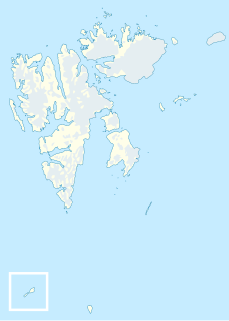
Svalbard and Jan Mayen is a statistical designation defined by ISO 3166-1 for a collective grouping of two remote jurisdictions of Norway—Svalbard and Jan Mayen. While the two are combined for the purposes of the International Organization for Standardization (ISO) category, they are not administratively related. This has further resulted in the country code top-level domain .sj being issued for Svalbard and Jan Mayen, and ISO 3166-2:SJ. The United Nations Statistics Division also uses this code, but has named it Svalbard and Jan Mayen Islands.

Edgeøya, occasionally anglicised as Edge Island, is a Norwegian island located in southeast of the Svalbard archipelago; with an area of 5,073 square kilometres (1,960 sq mi), it is the third largest island in this archipelago. An Arctic island, it forms part of the Søraust-Svalbard Nature Reserve, home to polar bears and reindeer. Its eastern side is covered by an ice field. The island is named after Thomas Edge, an English merchant and whaler. It is seldom visited today.

Van Mijenfjorden is the third-longest fjord in Norway's Svalbard archipelago. It lies in the southern portion of Spitsbergen island, south of Nordenskiöld Land and north of Nathorst Land. The fjord is 83 km (52 mi) long, being separated from Bellsund further out by Akseløya and Mariaholmen. The settlement of Sveagruva lies on the fjord's north bank.

Ross Archipelago is a name for that group of islands which, together with the ice shelf between them, forms the eastern and southern boundaries of McMurdo Sound in Antarctica. The most northerly is Beaufort Island, then comes Ross Island, the Dellbridge Islands, and Black Island and White Island. Frank Debenham's classic report, The Physiography of the Ross Archipelago, 1923, described "Brown Island" as a part of the group.
Halvmåneøya is a small, uninhabited Norwegian island off the southeastern coast of Edgeøya, part of the Svalbard archipelago. Halvmåneøya, as part of Edgeøya, has been a nature preserve since 1973, and visitation is strictly regulated.

Menkeøyane is a small Norwegian island group south of Halvmåneøya, an island off the southeast coast of Edgeøya. The group includes Havella, Alka, Gassen, Teisten, Islomen and Blåmåken. They comprise part of Thousand Islands. The islands are named after the German cartographer and historical geographer Heinrich Theodor Menke (1819–92). The islands appear on the Muscovy Company's map (1625), one of which is labeled Heling I.

Bölscheøya is an island southwest of Negerpynten, the southeastern point of Edgeøya. It is part of Thousand Islands. The island was named in 1868 by the German geographer August Petermann (1822–78) after the German journalist Carl Bölsche, father of the German writer and zoologist Wilhelm Bölsche (1843–93). The remains of a whaling station from the 17th century can be found on the island.

Kong Ludvigøyane is a small group of islands south of southwestern Edgeøya. The group includes Russebuholmane, Arendtsøya, Berentine Island, and Bruhnsøya. They form part of Thousand Islands. They are named after King Ludwig II (1845–86) of Bavaria, Germany. The islands may be the Hopeless Iles of the Muscovy Company's map (1625).

Brækmoholmane is an island group composed of three islands, Store Brækmoholmen, Trønderen and Alkekongen. They form part of Thousand Islands, an archipelago south of Edgeøya. The islands are named after the Norwegian sailor and fisherman Sivert Brækmo (1853-1930), who visited Svalbard regularly between 1876 and 1895.
Lurøya is the largest island in Tiholmane, part of Thousand Islands, an island group south of Edgeøya.
Trønderen is an islet in Brækmoholmane, part of Thousand Islands, an island group south of Edgeøya. The island is named after Trøndelag, Norway, the birthplace of Sivert Brækmo (1853–1930), a Norwegian sailor and fishermen who regularly visited Svalbard between 1876 and 1895.
Store Brækmoholmen is the largest island in Brækmoholmane, part of Thousand Islands, an island group south of Edgeøya. The island is named after Sivert Brækmo (1853-1930), a Norwegian sailor and fishermen who regularly visited Svalbard between 1876 and 1895.
Arendtsøya is a small island in Kong Ludvigøyane, part of Thousand Islands, an island group south of Edgeøya. The island is named after the German geographer Karl Arendts (1815–81).
Bruhnsøya is a small island in Kong Ludvigøyane, an island group in Thousand Islands, an archipelago south of Edgeøya. The island is named after the German astronomer Carl Christian Bruhns (1830–81).
Hornøya is the northernmost island in Tribotnane, part of Thousand Islands, an archipelago south of Edgeøya. Its name refers to the neighboring Lurøya.
Russeholmen is one of three islets that form part of Russeholmane, the westernmost group in Kong Ludvigøyane, part of Thousand Islands, an archipelago south of Edgeøya.
The Findlay Group is a group of islands in the Canadian Arctic Archipelago in Qikiqtaaluk Region, Nunavut. This Arctic Ocean group consists of Lougheed Island, Stupart Island, Edmund Walker Island, Grosvenor Island and Patterson Island.







